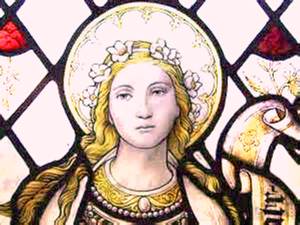Notebook
Fr Bernard Healy
I always tell visitors to Rome that they should rise early on at least one morning to visit St Peter’s Basilica when it opens, because that’s when it attracts pilgrims rather than tourists. So it was that I met an American friend and her family there just as the bells were ringing at 7am and the doors were opened a few days before Christmas.
I had arranged to meet them for an early Mass and headed to the sacristy – a room bigger than many Irish churches – where dozens of us priests were vesting and being directed to one of the many chapels and altars of the basilica.
From the sacristy my group was brought behind the main altar to the north-east corner of the basilica, to a part of the church that’s usually off-limits and to an altar that I’d never seen before. Above it was a large mosaic altarpiece –a young female saint being buried by two men, one of whom could be identified as St Peter, and the same woman being received into heavenly glory by Christ.
An information card told me that this was an altar that I had long heard about, but had not yet visited. The saint was the Virgin-Martyr St Petronilla, and her relics were entombed beneath the altar.
Like many early martyrs and saints, the historical record about Petronilla isn’t clear, but one particular tradition about St Petronilla says that she was the daughter of St Peter.
Scriptures
If you know your scriptures, you’ll remember that the gospels tell us that Our Lord healed St Peter’s mother-in-law from a fever when he visited Capernaum. You’ll also remember the dialogue between St Peter and Christ about the apostles leaving “houses or brothers or sisters or father or mother or wife or children or fields” (Matthew 19:29) for the sake of Christ and the Gospel, so there is a suggestion that at least some of them had children before they took up their Apostolic mission. Indeed, the 2nd Century writer St Clement of Alexandria said that of the 12, St Peter and St Philip both had children before their calling.
One particular tradition about St Petronilla says that she was the daughter of St Peter”
He then goes on to say that St Philip arranged for his daughters to be married, but says nothing of St Peter’s family – so the idea of him having an unmarried daughter is perfectly plausible.
As well as the oral tradition about her, there is an interesting 4th Century image of St Petronilla in one of the catacombs – it shows her receiving a deceased Christian into heaven, a task usually associated with her father.
There’s other evidence too – some favouring her being the daughter of Peter, other evidence suggesting that she might have been a spiritual daughter (i.e. convert) of the apostle or that she may have even died too late to be part of Peter’s family. So, the question of her precise identity remains open, but it was nonetheless a privilege to celebrate Mass at her tomb.
Next to the altar of St Petronilla are a couple of marble plaques recording her particular association with France. One explains that Petronilla had been buried at the catacombs of Domitilla, but in the year 757 Pope Paul I entrusted her relics to Pepin the Short, King of the Franks, who had done much to support the Church and Papacy. She was moved to a circular mausoleum next to old St Peter’s Basilica and this became the chapel of the Kings of France. Because of the long relationship between this Kingdom and the Papacy, France became known as the Eldest Daughter of the Church, and so it was fitting that St Peter’s daughter should be the King’s patron.
The building of present-day St Peter’s Basilica meant that St Petronilla’s relics were moved to their present location in 1606. Nothing survives of the original chapel of the French kings.
However, as the second plaque records, when the Bishops of France came to Rome in 1889 they asked Pope Leo XIII that the altar of St Petronilla should be a place of special prayer for the Church in France. The French Church didn’t always have an easy history under the sometimes dubious protection of the French Kings, but it suffered active persecution during the French Revolution and under several of the aggressively anti-clerical governments that followed.
Petronilla now stands as a patron, not just of the French Kings, but as a protectress of the French Church as a whole.
Her feast-day is May 31 and the French gather for Mass at her altar on that day.


 Saint Petronilla
Photo: Bloggerpriest.com
Saint Petronilla
Photo: Bloggerpriest.com 